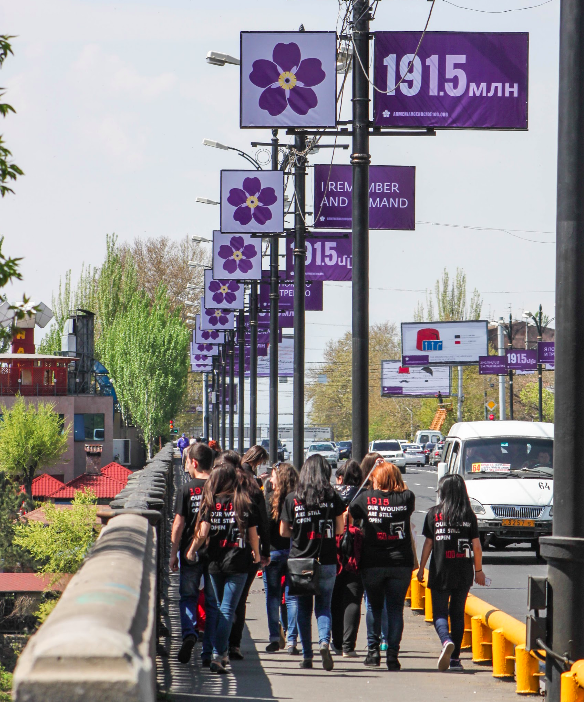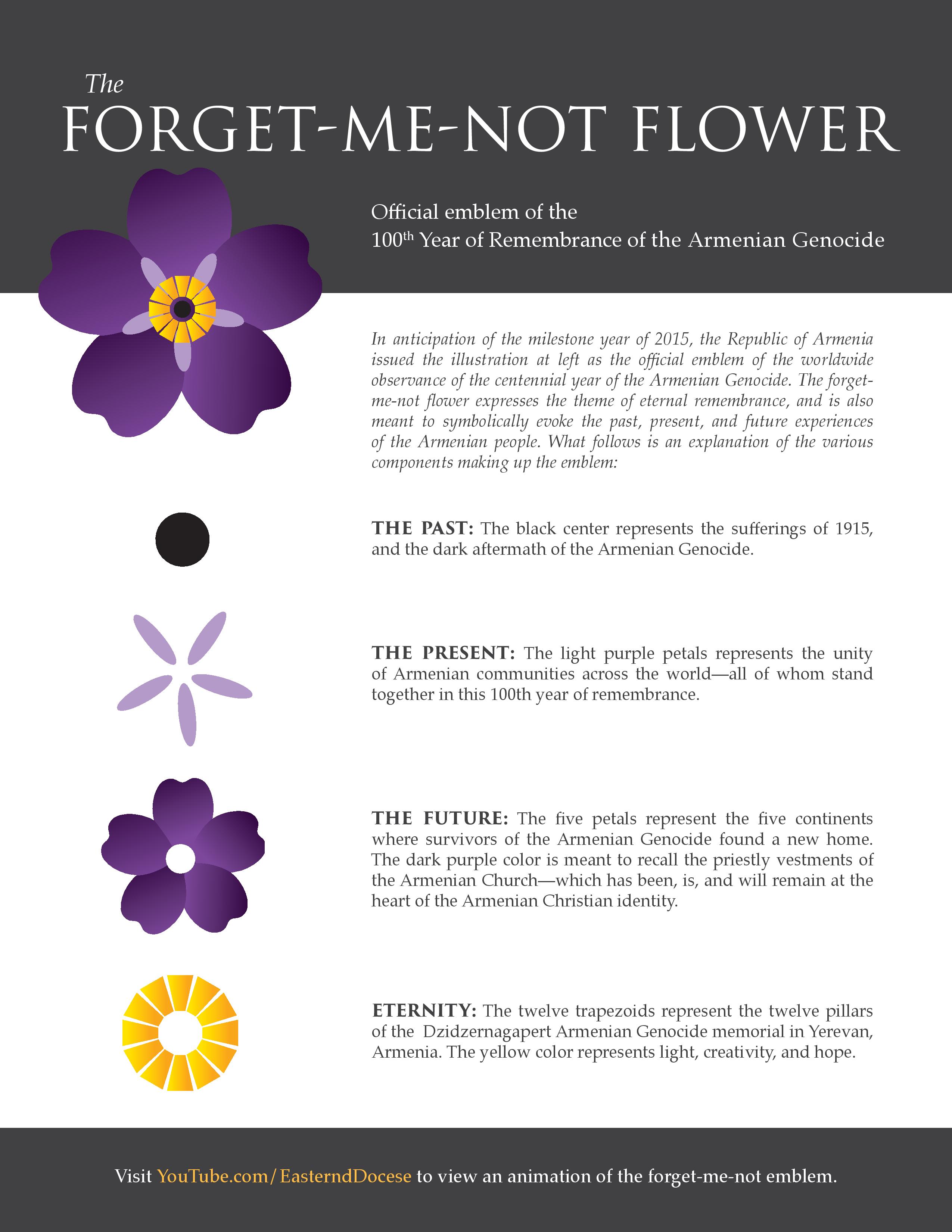
Armenian students walking towards Genocide Museum, surrounded by the Centennial emblem. Photo taken by Joey Ayoub.
This Friday, April 24, is an important date to Armenians worldwide. It will mark 100 years from the day when Ottoman authorities began rounding up around 250 Armenian intellectuals and community leaders in Constantinople, paving the way for the Armenian Genocide in which an estimated 1 to 1.5 million Armenian citizens of the Ottoman Empires were systematically exterminated between 1915 and 1918.
All around Yerevan, the purple colors of the aptly-named Forget-Me-Not Flower can be seen everywhere. From schoolchildren carrying it in the form of a pin on their chests to coffee-drinking university students displaying it in the form of a sticker on their laptop. Everywhere, streets, homes, hospitals, supermarkets, restaurants, shops and hotels are all displaying the flower with a simple message: “I Remember and Demand.”

Yerevan woman sitting at a public park with a living statue of a piano with Forget-Me-Not flowers on it. Photo taken by Joey Ayoub.
Remembering the Genocide and demanding recognition from the Republic of Turkey, the legal successor to the the Ottoman Empire, have been part of virtually every Armenian's life and identity for the past century. Generation after generation, the survivors of the Armenian Genocide and their descendants have been campaigning for the international community to recognize the fact. To date, only 21 countries have fully recognized the Armenia Genocide including France, Italy, Lebanon and Russia.
The Forget-Me-Not flower can be seen planted all around Yerevan. As The Eastern Diocese of the Armenian Church of America explained, the Forget-Me-Not “expresses the theme of eternal remembrance, and is also meant to symbolically evoke the past, present, and future experiences”.
As for the upcoming days, several events from concerts to conferences are planned to commemorate the Genocide. This Global Voices author will be participating in the Against the Crime of the Genocide Global Forum, which is bringing together more than 500 participants from all over the world, including political, religious and public figures, journalists and editors.
Further posts about the event will be appearing on Global Voices. Stay tuned.








6 comments
The decision to blame a nation with genocide guilt is
under the authority of UN’s OSAPG office and UN procedures carried by
special UN secretary for genocide affairs in an international court. US and
world documents by thousands evidence the various revolutions of Armenian
volunteers, gangs and troops and sabotaging the Turkish Army’s logistic
lines, who were fighting British at Dardanels and Russians in the Caucasus.
This “military measure” was successful, when there were no homes to
shelter and feed them the Revolutionaries evacuated the area. Wrong doings
during the war chaos and insufficient guarding of immigrants were punished in
early 1916 over 1600 martial courts, whereby over some 1200 suspects were
heavily penalized and 67 of them executed. As for the Holocost, did German
Government punished any Nazi Commander or any soldier? Compare the
Ottomans and Germans impartially. Thanks…
Jewish Holocaust is proven at Nuremberg , but Armenian claims were never
tested at a court of law. Armenian claims are mostly based on hearsay and
forgeries and, therefore, do not even have the slimmest chance of withstanding
the scrutiny of a courtroom. Armenians know this well which is why they avoid
courts on this issue like a plague (they will sue the insurance companies for
money but not Turkey at ICJ for genocide claims. http://www.tallarmeniantale.com )
Armenians find it easy to distort and misrepresent a true suffering of all
peoples of Anatolia (not just Armenians) via media, academia, politics,
religion, and other avenues where both information and opinions can be
manipulated, molded, bought, or sold. Armenians deliberately exaggerate and
falsify stories of human suffering and use it interchangeably with the term genocide,
ignoring the fact that not all suffering is genocide. For a war crime to be
genocide, the intent must be proven at a court of law. To date, not a single
document has been unearthed in the Ottoman archives which substantiate Armenian
claims. This led the Armenians to fabricate some, like the infamously fake
telegrams of Talat forged by Andonian, the tall tales and bogus stories in
Toynbee’s wartime propaganda book, the Blue Book, and more . All of this
tainted propaganda material which the Armenians still use today were flatly and
categorically rejected by the British crown prosecutors who refused to use them
as evidence in the stillborn Malta Tribunal (1919-1921.)